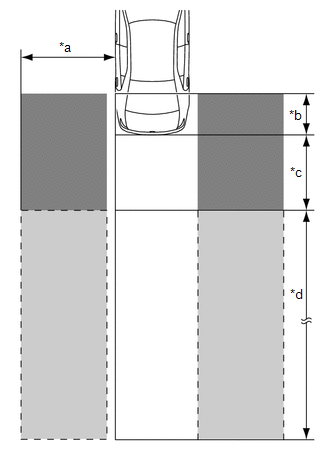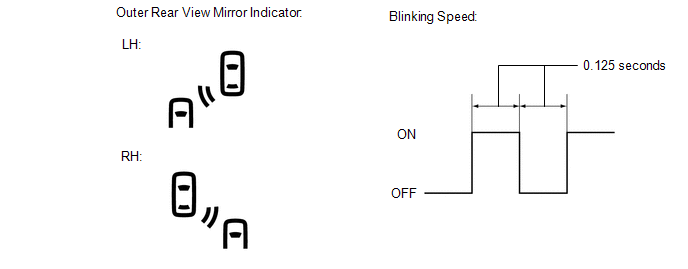Lexus ES: System Description
SYSTEM DESCRIPTION
GENERAL
(a) The blind spot monitor system has a blind spot monitor function.
(1) Blind spot monitor function
-
The blind spot monitor function is a function that assists the driver when changing lanes.
This function uses quasi-millimeter wave radar to detect vehicles that are traveling in adjacent lanes in the areas that are not visible using the outer rear view mirror assemblies (blind spots) and vehicles that are approaching rapidly from up to 60 m behind this vehicle in the areas that are not visible using the outer rear view mirror assemblies (blind spots).
The function advises the driver of the existence of a vehicle by illuminating the outer rear view mirror indicator on the outer rear view mirror assembly.
- If the turn signal switch is operated while the outer rear view mirror indicator on an outer rear view mirror assembly is illuminated, the indicator starts blinking to give additional warning to the driver.
FUNCTION OF COMPONENTS
| Component | Function |
|---|---|
| Blind Spot Monitor Sensor |
|
| Outer Rear View Mirror Assembly
| Turns on or blinks the indicator based on a signal from the blind spot monitor sensor. |
| Steering Pad Switch Assembly | Enables, disables or cuts off the operation of the blind spot monitor system by transmitting switch operation signals to the combination meter assembly. |
| RCTA Buzzer (Blind Spot Monitor Buzzer) | Sounds based on a signal from the blind spot monitor sensor. |
| Combination Meter Assembly
|
|
| Main Body ECU (Multiplex Network Body ECU) | Transmits the destination information and the dimmer signal to the blind spot monitor sensors via CAN communication. |
| Skid Control ECU | Transmits a vehicle speed signal to the blind spot monitor sensors via CAN communication. |
| ECM | Transmits a shift position signal (R) to the blind spot monitor sensors via CAN communication. |
| Steering Sensor | Detects the angle of the steering wheel and transmits the resulting signals to the blind spot monitor sensors via CAN communication. |
| Airbag Sensor Assembly
| Transmits the yaw rate signal to the blind spot monitor sensor via CAN communication. |
| Receives the blind spot monitor sensor information via CAN communication and sends it to the multi-display assembly through the video signal cable. |
| Multi-display Assembly |
|
- *1: w/ Parking Assist Monitor System
- *2: w/ Panoramic View Monitor System
OPERATION DESCRIPTION
(a) Operation description of the blind spot monitor system
(1) Operation conditions:
- The blind spot monitor system is on.
- The shift lever is in any position other than R.
- Vehicle speed is more than approximately 16 km/h (10 mph).
(2) Conditions in which a sensor can detect a vehicle
The blind spot monitor system indicates detection of a vehicle in the detection area when either condition is met:
- When a vehicle is detected in an adjacent lane overtaking this vehicle.
- When a vehicle is detected entering the detection area because it changed lanes.
(3) Detection area
Vehicles in the following areas can be detected:

| *a | Within Approx. 3.5 m (11.48 ft.) from Side of Vehicle |
| *b | Within Approx. 1 m (3.28 ft.) Forward of Rear Bumper |
| *c | Within Approx. 3 m (9.84 ft.) Behind Rear Bumper |
| *d | Within Approx. 3 m (9.84 ft.) to 60 m (196.86 ft.) from Rear Bumper |
.png) | Detection Area (for Vehicle in Blind Spot) |
 | Detection Area (for Rapidly Approaching Vehicle from Behind) |
OPERATION OF OUTER REAR VIEW MIRROR INDICATOR
(a) Initial check
(1) When the blind spot monitor system is turned on with the engine switch on (IG), the outer rear view mirror indicators on the outer rear view mirror assembly illuminate for 3 seconds.
(2) When the engine switch is turned from off on (IG) with the blind spot monitor system on, the outer rear view mirror indicators on the outer rear view mirror assembly illuminate for 3 seconds.
(b) Operation for each function
(1) Operation for blind spot monitor system
- When a sensor detects a vehicle in the blind spot area, the outer rear view mirror indicator on the outer rear view mirror assembly illuminates.
- If the turn signal switch is operated while the sensor is detecting a vehicle in the detection area and the outer rear view mirror indicator on the outer rear view mirror assembly is illuminated, the indicator starts blinking as shown in the illustration.


